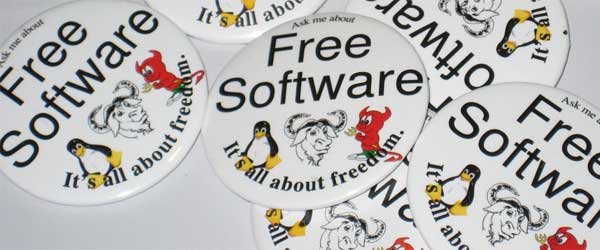Bio-Software for Linux

After Peter’s Introduction to Linux, those of you brave enough to accept the challenge will now have Linux installed on your machine so today I want to highlight to you some of the wonderful free software that is available for biologists using Linux.
Before I start, I should mention that virtually all tools of modern life science research run on Linux since most of them were first written on a Linux/Unix machine and were later adapted to other Operating Systems. Some of them run exclusively on linux, but those are for the more serious stuff e.g. denovo genome assemblies.
First, if a nice desktop is a must…
And I should also say this: Most of those programs are not about fancy graphics, some of them will not have a GUI (Graphical User Interface). But what they lack in prettiness, they more than make up for with speed and power. However, if you can’t live without a nice Desktop Linux can still meet your needs. Check out these nice examples at Lifehacker and for a more comprehensive listing click here.
Bio-distros. Where to start.
If you followed Peter’s instructions, you will now have a normal Linux installation on your machine and you can now install some Bio Software Packages. Note that if you are starting from scratch, an alternative option is to install a Bio-Focussed Linux distro in which the operating system comes packages with bio software.
There are several Distros especially focused on Bioinformatics and everyday Labtools from which you take your pick. I would recommend the Live-DVD, BioLinux, which is. You can take Biolinux for a test drive directly from the DVD and, as Peter mentioned, it can later be installed from the same DVD if your decide to use it.
BioLinux comes with an array of useful bio software, everything from sequence comparisons (all flavours of Alignments, phylogenetic Trees) and the EMBOSS package to the CLCWorkbench and the Staden Package. The full list for BioLinux can be found here.
To install BioLinux from Scratch:
Download BioLinux and test drive or install it, following Peter’s instructions. The software will be installed along with the operating system.
To install the BioLinux software in an already installed version of Ubuntu:
In order to install software with Ubuntu you simply use the build in package Manager Synaptic. You can open it via System? SystemManager ? Synaptic PackageManager. Then you simply need to search for the package you want, select it, hit apply and you are set.
Alternatively you can search the web with the keywords “Software + Ubuntu” or “Software + deb” (the packages used for Ubuntu have the ending .deb).At the download screen tell your browser to open the package with the package manager, and Ubuntu does the rest for you.
You will always be asked for a password before you can install anything. This is one of the many reasons why Linux is safe.
Build your own…
No ready-made package available? No problem, you can rearrange packages from other Distributions like .rpm or you can compile the program yourself. Since explaining both of these would take some time and there really is no universal way of doing this, simply use your favorite search engine, and somebody will have the answer ready for you. I just wanted to mention it here so you know it is a possibility.
This by the way is another advantage of Linux, the community is huge. If you run into an error, simply copy/paste it into your search engine of choice and you most probably will find an answer.
Other Bio-Distros you could consider
- DNALinux (based on the Live-DVD-System SLAX), which can be run inside a virtual machine from Windows.
- BioBrew (based on RedHat) is your candidate if you have more serious ambitions, such as setting up a cluster (of computers that distribute the maths amongst them)
- DebianMed, which also contains a lot of BioPackages and some packages focused towards medicine and pharmacy.
One of the few programs you might need that is not available for Linux is VectorNTI. But never fear, there is still a workaround using a program called WINE, which allows you to run some Windows Programs within Linux. To install WINE, simply open Synaptic (as described above), search for it, and be happy 🙂 and you can easily find instructions on how to install VectorNTI 10 by seaching Google.
Let’s get hooked on Linux!
5 Comments
Leave a Comment
You must be logged in to post a comment.
hey!
I was thinking if you could recommend some good pathway designer software.You know it really takes a lot of time for somebody not well versed with GIMP/photoshop/illustrator/corel to make their pathway images or explain concepts using pictures for some publication or for teaching to students or for condensing matter from various papers..
And also is there a place to download stock images for making such illustrations?
Kindly help…or maybe write an article on the same!(don’t forget to care about windows users too)
cheers
sameer
Hi Sameer,
try CellDesigner. Should be available in JAVA- Meaning Cross Platform.
You can export in SVG-Format, which you then can perfectionize with the excellent inkscape.
Rock On
Johannes
you can try out linux as a liveCD or boot off a thumbdrive with
bioslax
vectorNTI?
try genieous (typos?)
or clcbio
they are written in java
@Etienne
Thanks for commenting and the suggestion. I will collect them and integrate them in another Article I want to write about Bio-Informatics-Software. There just is so much good stuff out there.
Hi !
Again … really good point to promote Linux.
Just wanted to add one distro called PhyLIS. I didn’t tried it but seems to be quite handy for Phylogenetic and Evolutionary purposes. And that’s were I found an apparently (freshly installed) nice alternative to BioEdit called Jalview.
For the websites :
https://www.eve.ucdavis.edu/rcthomson/phylis/
https://www.jalview.org/